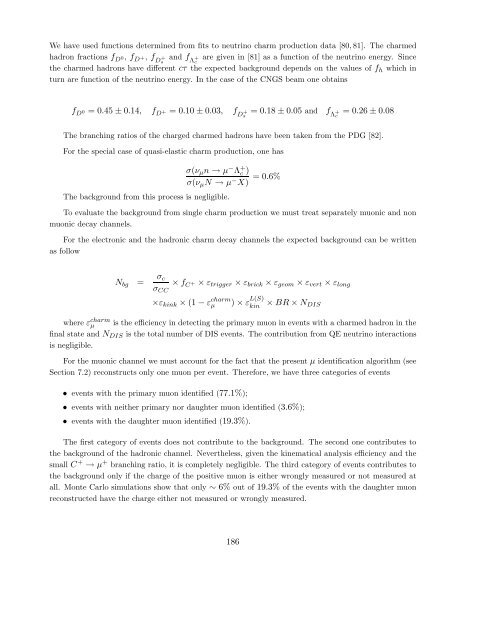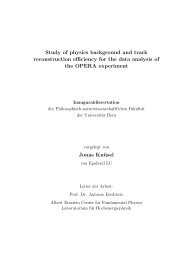Experiment Proposal - opera - Infn
Experiment Proposal - opera - Infn
Experiment Proposal - opera - Infn
Create successful ePaper yourself
Turn your PDF publications into a flip-book with our unique Google optimized e-Paper software.
We have used functions determined from fits to neutrino charm production data [80, 81]. The charmed<br />
hadron fractions f D 0, f D +, f D<br />
+<br />
s<br />
and f Λ<br />
+<br />
c<br />
are given in [81] as a function of the neutrino energy. Since<br />
the charmed hadrons have different cτ the expected background depends on the values of f h which in<br />
turn are function of the neutrino energy. In the case of the CNGS beam one obtains<br />
f D 0 =0.45 ± 0.14, f D + =0.10 ± 0.03, f D<br />
+<br />
s<br />
=0.18 ± 0.05 and f Λ<br />
+<br />
c<br />
=0.26 ± 0.08<br />
The branching ratios of the charged charmed hadrons have been taken from the PDG [82].<br />
For the special case of quasi-elastic charm production, one has<br />
The background from this process is negligible.<br />
σ(ν µ n → µ − Λ + c )<br />
σ(ν µ N → µ − X) =0.6%<br />
To evaluate the background from single charm production we must treat separately muonic and non<br />
muonic decay channels.<br />
For the electronic and the hadronic charm decay channels the expected background can be written<br />
as follow<br />
N bg = σ c<br />
σ CC<br />
× f C + × ε trigger × ε brick × ε geom × ε vert × ε long<br />
×ε kink × (1 − ε charm<br />
µ ) × ε L(S)<br />
kin<br />
× BR × N DIS<br />
where ε charm<br />
µ is the efficiency in detecting the primary muon in events with a charmed hadron in the<br />
final state and N DIS is the total number of DIS events. The contribution from QE neutrino interactions<br />
is negligible.<br />
For the muonic channel we must account for the fact that the present µ identification algorithm (see<br />
Section 7.2) reconstructs only one muon per event. Therefore, we have three categories of events<br />
• events with the primary muon identified (77.1%);<br />
• events with neither primary nor daughter muon identified (3.6%);<br />
• events with the daughter muon identified (19.3%).<br />
The first category of events does not contribute to the background. The second one contributes to<br />
the background of the hadronic channel. Nevertheless, given the kinematical analysis efficiency and the<br />
small C + → µ + branching ratio, it is completely negligible. The third category of events contributes to<br />
the background only if the charge of the positive muon is either wrongly measured or not measured at<br />
all. Monte Carlo simulations show that only ∼ 6% out of 19.3% of the events with the daughter muon<br />
reconstructed have the charge either not measured or wrongly measured.<br />
186




